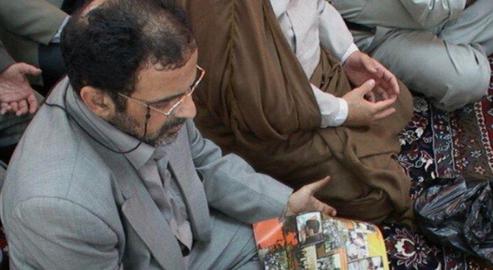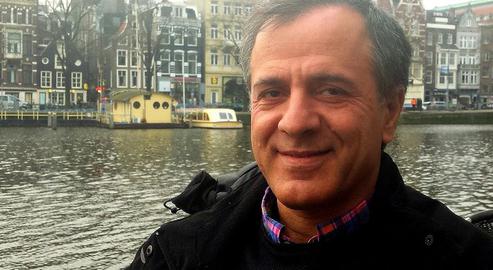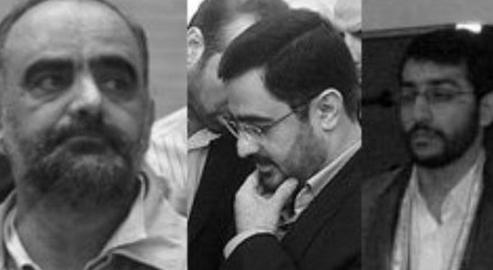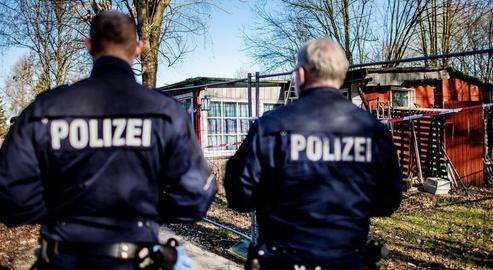Earlier this month, one of Iran’s most notorious puppet judges quietly passed away after contracting Covid-19. News surfaced that Hassan Zare Dehnavi, better known as Judge Haddad, had died on Wednesday, October 28. It prompted an outpouring of reaction from students, activists and others painfully affected by this judge’s rulings in the Revolutionary Courts during his lifetime.
Beginning as an interrogator at Evin Prison, Haddad went from personally shooting prisoners to taking up the judge’s chair in the Revolutionary Courts. He presided over the torture and imprisonment of countless activists and journalists, including attendees at the Berlin Conference, and had scores of Iranian civilians detained and brutalized at the infamous Kahrizak Detention Center, where several were beaten to death. IranWire has spoken to several people who were tried by Judge Haddad over the years.
***
Hassan Zare Dehnavi, who operated under the alias Hassan Haddad, entered Iran’s judiciary in 1981 without fanfare, shortly after the Islamic Revolution. He did so on the introduction of Asadollah Lajvardi, then-chief prosecutor of Tehran, who would later come to be known as “the butcher of Evin Prison”.
Throughout the 1980s, “Haddad” served as an interrogator and torturer at Evin Prison. Little is known about his activities in the early years – save for the fact that he, too, became infamous for brutality disguised as revolutionary zeal.
Iraj Mesdaghi, a former political prisoner who was detained at Evin in the 1980s, writes that Haddad was one of many employees of Evin Prosecutor’s Office who personally took up a machine gun and shot condemned prisoners in the chest to prove his devotion to the regime. “In those years,” he writes, interrogators would beg the prosecutors to put their names on the list of execution squads, so that they would not be deprived of this great honor.”
Following the 1988 massacres of political prisoners in Iran, Haddad was abruptly relieved of his duties at Evin. This, according to Mesdaghi, was due to “financial and moral violations” that occurred on his watch.
Mohammad Ali Sarlak, a then-firing squad member who himself was arrested in 1985 for taking bribes from political prisoners’ families, has alleged that Haddad and his cronies had turned the prison into a “center of corruption”. “They make millions and millions,” Sarlak later told his fellow prisoners, “and no one cares!
“Also, the cells of Evin Sanatorium and Ward 209 [a secret section of the prison in which detainees are kept in solitary confinement and subjected to medieval torture methods, overseen by the Intelligence Ministry] have been turned into amusement parks.”
A Career Built on Suppressing Dissent
Despite being sacked from Evin Prison for financial misconduct, Haddad then walked into a role inspecting confiscated property in the enforcement team for the Executive Headquarters of Imam's Directive. By that time the organization had amassed a small fortune and become the cornerstone of the Supreme Leader’s financial empire. Here, as in Evin, allegations of financial malpractice saw Haddad forced from the post.
But Haddad was nonetheless able to re-enter the judiciary in the late 1990s, when the branch was being presided over by the cleric Mohammad Yazdi. This time, having since obtained a degree in Islamic law, he was placed in the judge’s seat at he became head Branch 26 of the Revolutionary Court, initially in charge of trying drug and antiquities traffickers. Later, he was given more and more politically sensitive cases, and was finally named deputy prosecutor for security affairs in 2006.
Judge Haddad presided over many of the trials and sentencings of Iranian reformists who were arrested in connection with attending the 2000 Berlin Conference on political reform in Iran. Among these were journalist Akbar Ganji, activist Ezatollah Sahabi and students from the pro-democracy group Office for Strengthening Unity and others. In the same year he also handed a custodial sentence to Amir Farshad Ebrahimi, an ex-vigilante who had claimed his contemporaries were paid by clerics to carry out attacks on reformist personalities, and was later instrumental in crackdowns on journalists such as Fereshteh Ghazi throughout the early 2000s.
Judge Haddad was one of the architects of the infamous Kahrizak Detention Center, a sprawling complex first set up in 2001 on the pretext of housing drug addicts and so-called “thugs”. Reports of inhumane treatment, sexual abuse and extrajudicial killings at the camp are rife, with some ex-detainees calling it worse than Evin Prison’s Ward 209.
In 2009, after the mass demonstrations over the contested presidential election result, Haddad ordered that some of the detained protesters be sent to Kahrizak. Just 50 of the most “dangerous” people were supposed to be placed there, but it later transpired that the camp was holding at least 140 “low-risk” civilian activists. Several of them met their deaths there, including Mohsen Ruholamini, a graduate student and the son of a prominent Iranian conservative politician. The medical report on Ruholamini's death stated that he had died of "physical stress, the effects of being held in bad conditions, multiple blows and severe injuries to the body."
Eventually in 2013 Judge Haddad and two other senior judiciary figures, Saeed Mortazavi and Ali Akbar Heydarifar, faced criminal proceedings for the torture and death of three detainees in Kahrizak. In a trial that took place wholly behind closed doors, all three were barred for life from holding judicial posts and barred for five years from governmental jobs.
After the case closed in August 2015, a survivor of Kahrizak, Masoud Alizadeh, told Iran Human Rights that all three men should have been held answerable for the rest of the abuse that took place at the camp. “We were all tortured close to death,” he said. “Some died and we lived, but no one saw us. The judicial authorities did not investigate our case. I wish those with a voice could mention what happened to us as well.”
Prisoners Abused on Judge Haddad’s Orders: ‘Do You Remember?’
People with first-hand experience of Judge Haddad’s behavior have spoken out about their recollections in the aftermath of his death. Shiva Nazarahari, a human rights activist, wrote on Twitter: "My first time in court, he looked into my 18-year-old’s eyes, laughed, and fined me 200,000 tomans for carrying four candles.”
A former student activist, who was tried by Judge Haddad in the Revolutionary Court in the 2000s, told IranWire: “During my days of solitary confinement, I endured all kinds of physical and psychological torture. But Haddad had a complex approach compared to other, more violent security judges. He was constantly trying to make friends with me.
“I met with him two or three times, both during and after my detention, to argue my case. Once, I remember, he even asked me for forgiveness. He said that if he had put pressure on me, it was because it was his duty and out of his hands... which, of course, I did not believe.”
Kianoush Sanjari, a journalist and activist who was repeatedly arrested during the so-called “reform era” from 1997 to 2005, later published his memories of the torture he endured in the form of an open letter to Judge Haddad.
“If you remember,” he wrote, “Seyed Majid, the head of your office in Branch 26 of the Revolutionary Court, slapped the defendants in the face in front of the lawyer and insulted their families. Do you remember?
“Have you forgotten that in 2001, you came with Seyed Majid to the Revolutionary Guards’ Detention Center 59 and met a group of prisoners linked to the Coalition of Nationalist-Religious Activists, and you also met me? Mr. Majid slapped me hard in the in your presence in the center’s yard. Do you remember that in 2001, in order to further humiliate me, you ordered my head to be shaved in the court building basement?
“Do you remember that in one room of Branch 26 of the Revolutionary Court, Mr. Seyed Majid, in the presence of yourself and in the presence of the mother of one of the detainees, gave the young man a spoon to go and swallow his feces with, after which you’d agree not to send him back to prison?”
Ali Afshari, a student activist and member of the Office for Strengthening Unity, was held for nearly a year in the same detention center and Evin Prison in the early 2000s on the orders of Judge Haddad. His arrest had coincided with the detention of a large number of nationalist-religious activists and speakers at the Berlin Conference by the IRGC and the police.
“Judge Haddad,” he told IranWire, “was a clear example of the non-independence of the judiciary from the security services. At the time, parallel agencies were plotting an overnight coup against Mohammad Khatami's government, leading to widespread arrests of critics and dissidents. Judge Haddad was their judicial front.”
Reza Alijani, another activist who was arrested around the same time as Ali Afshari, told IranWire: “At that time the intelligence services had just begun appointing puppet judges to the Revolutionary Courts: usually select individuals with an array of personal weaknesses, be they moral, financial or political. Haddad was said to have issues in all these areas, making him a completely obedient figure. Our interrogators said on several occasions that the judge was ‘useless’, and when we told Haddad what they had said, he didn’t even react."
At the time, the cause of the detained nationalist-religious activists had been taken up by concerned parties all around the world. Alijani says media coverage of their case seemed to make Judge Haddad nervous. “Once he shouted, ‘They’re upsetting us! Every day there are new stories and controversies published about you.”
Student activist Mahdieh Golrou was also among those whose case was reviewed by Judge Haddad. This week, she tweeted: “Now that Judge Haddad is dead, I do not know if I am happy or sad. He died without a trial.”
Related coverage:
Who are Iran’s Judges and Who Gives Them the Right to Make Decisions About People's Lives?
Kahrizak Survivors: Mortazavi’s Apology Opens Old Wounds
visit the accountability section
In this section of Iran Wire, you can contact the officials and launch your campaign for various problems



























comments